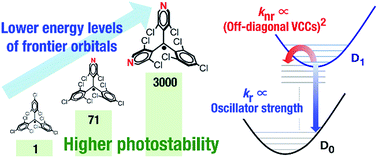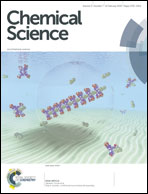A luminescent organic radical with two pyridyl groups: high photostability and dual stimuli-responsive properties, with theoretical analyses of photophysical processes†
Abstract
Luminescent monoradicals are expected to show unique properties based on their doublet state, where establishing a method to improve their photostability is an important issue for expanding their photofunctionality. We synthesized a highly photostable luminescent organic radical, the bis(3,5-dichloro-4-pyridyl)(2,4,6-trichlorophenyl)methyl radical (bisPyTM), containing two pyridyl groups on a tris(2,4,6-trichlorophenyl)methyl radical (TTM) skeleton. bisPyTM in dichloromethane exhibited fluorescence with an emission peak wavelength, λem, of 650 nm. We visually detected an emission (λem = 712 nm) from crystalline bisPyTM at 77 K, which is the first example of definite solid-state emission in a radical. Introducing the two nitrogen atoms into the TTM skeleton was shown to lower the energies of the frontier orbitals. The oscillator strength, f, of the electronic transition between the lowest excited state and the ground state, and the off-diagonal vibronic coupling constants (VCCs) were calculated theoretically for bisPyTM and the (3,5-dichloro-4-pyridyl)bis(2,4,6-trichlorophenyl)methyl radical (PyBTM). The calculated PyBTM to bisPyTM ratios for f or VCC agreed well with experimental radiative and non-radiative rate constants (kr and knr) ratios, respectively. This study shows that scaled kr and knr can be estimated and compared in this class of radicals using theoretical calculations, greatly advancing the prediction and design of their photofunctionality. The half-life of bisPyTM upon continuous UV light irradiation in dichloromethane was 47 or 3000 times longer those that of PyBTM (which contains one pyridyl group) and TTM (which has no pyridyl rings), respectively. The electrochemical and luminescent properties of bisPyTM were modulated in two stages using protons or B(C6F5)3.



 Please wait while we load your content...
Please wait while we load your content...